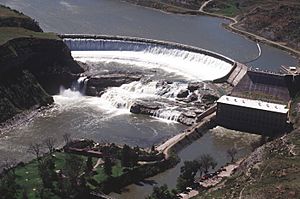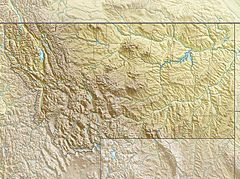Big Falls (Missouri River waterfall) facts for kids
Quick facts for kids Big Falls |
|
|---|---|

Big Falls and Ryan Dam
|
|
| Lua error in Module:Infobox_mapframe at line 185: attempt to index field 'wikibase' (a nil value). | |
| Location | Near Great Falls, Montana |
| Coordinates | 47°34′07″N 111°07′27″W / 47.56862°N 111.1241°W |
| Type | Segmented block |
| Total height | 87 ft (27 m) |
| Number of drops | 1 |
| Total width | 900 ft (270 m) |
| Watercourse | Missouri River |
| Average flow rate |
8,500 cu ft/s (240 m3/s) |
Big Falls is a large waterfall found on the Missouri River in western Montana, United States. It is also known as Great Falls or Roar of Steam. This waterfall is the biggest and lowest of the group called the Great Falls of the Missouri.
Big Falls is about 87 feet (27 m) tall. It can be up to 900 feet (270 m) wide when a lot of water is flowing. In the past, the falls always had a powerful flow. Today, much of the water is sent away to make electricity. This happens at the Ryan Dam, which is upstream. Because of this, the falls might look like a small trickle during the summer. The dam has made the total height of the water at this spot 177 feet.
Discovering Big Falls
The Mandan people, a Native American tribe, knew about these waterfalls long ago. They had a special name for the group of falls. They called them Minni-Soze-Tanka-Kun-Ya. This name means "the great falls."
Naming the Falls
The specific waterfall known as Big Falls got its name in 1805. It was named by William Clark, who was part of the famous Lewis and Clark Expedition. This expedition explored the western parts of North America.
Nature Around Big Falls
The area around Big Falls is home to many interesting plants and animals. You can find cottonwood trees growing nearby. The land around the falls is also a type of shrubland.
Wildlife at the Falls
This shrubland environment is perfect for certain plants and animals. You might see juniper plants growing there. Animals like mule deer also live in this area. Eagles are often seen flying overhead. Many different kinds of birds make their homes below the falls.


